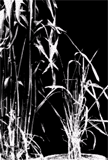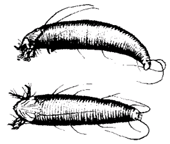|
Wheat streak mosaic, caused by the wheat streak mosaic virus (WSMV),
is a serious and widely distributed disease of winter wheat. Wheat
streak mosaic also occurs on spring wheat and barley, corn, rye,
oats, and a number of annual and perennial grasses (Table 1). It
was first recognized in Nebraska as "yellow mosaic" in
1922. Since then, although sporadic in its appearance and severity,
wheat streak mosaic has caused losses throughout central and western
North America, eastern Europe, parts of Russia, and North Africa.
Wheat streak mosaic is most prevalent and damaging in the central
Great Plains area of the United States. The first serious outbreak
of the disease occurred in Kansas in1949, when the loss was estimated
at $30 million. In 1959, the loss from wheat streak mosaic in the
same state amounted to $80 million.
Damage to winter wheat is most severe in fields planted next to
volunteer wheat or cereal stubble that was not plowed down before
sowing. Yield losses in wheat can be as high as 100 percent, depending
on the time of infection and other factors. The greatest loss occurs
in fall-infected fields that were seeded early. Plants that become
infected in the early spring develop leaf symptoms, and yield losses
range from 0 to 30 percent. Infections that occur in the late spring
usually cause little or no loss in yield or in grain quality although
losses up to 98 percent have been reported.
Wheat streak mosaic was first found in Illinois in 1966, near Brownstown.
During 1967, it was positively confirmed from wheat collected in
the following counties: Bond, Clinton, Fayette, Franklin, Hamilton,
Jackson, Jasper, Monroe, Piatt, Richland, St. Clair, and Washington.
The disease was probably present in other counties, but was not
detected.
In May of 1967, an extensive survey of wheat fields through the
southern half of Illinois revealed wheat streak mosaic in every
field of volunteer wheat surveyed as well as in wheat fields adjacent
to or near volunteer wheat. These observations were supported by
positive recoveries of the WSMV and by positive transmission with
the mite vector in greenhouse tests.
During 1976 and 1977 outbreaks of the disease in Illinois, serious
economic losses occurred on wheat, sweet corn, and dent corn in
Madison, Monroe, and St. Clair counties. Field surveys showed that
the WSMV was generally distributed south of Springfield and west
of interstate 57. Scattered damage to wheat and dent corn was observed
in Fayette, Jackson, Macoupin, Perry, Randolph, Sangamon, and Washington
counties.
Damage to wheat was closely associated with double-cropping and
the presence of volunteer wheat. Damage to sweet and dent corn was
associated with wheat fields infected with the WSMV. Most severe
losses occurred where corn was infected early in its growth. A lack
of pollination and small ears were common on corn plants infected
by wheat streak mosaic.
|

Figure
1. Left, healthy wheat leaf; chlorotic leaf streaks parallel
to the veins caused by virus infection.
|
Back to Top
Symptoms
The distribution of wheat streak mosaic is closely related to the dispersal
of its mite vector. Margins of fields are commonly the first and at times
the only areas affected. Although winter wheat is commonly infected in
the fall, symptoms of wheat streak mosaic do not normally appear until
the onset of warm weather in the late winter or the following spring.
However, cereals that were planted in late summer or early fall occasionally
show symptoms in the autumn. The first symptoms in the leaves consist
of blotches and discontinuous dashes or streaks that are light green to
a faint yellow. These areas are parallel to the veins. Later, growth of
affected plants is retarded and leaves show a general yellow mottling,
except for a few green streaks or blotches (Figure 1). Infected plants
tend to spread out more than normal ones, frequently developing an abnormally
large number of tillers. Some culms may grow to normal height and head-out,
while others do not. Tillers in the same plant vary considerably in height
(Figure 2). As the winter wheat plants mature, the yellow leaves tend
to turn brownish and die. It is not uncommon to find stunted plants with
sterile heads still standing after harvest – just the height of,
or shorter than, the stubble.
|

Figure
2. Left, normal wheat plant; right, extreme dwarfing of a wheat
plant due to virus infection.
|
In some fields, a high reduction in the yield and grade of the
grain often results from complete or partial sterility and shriveled
kernels. If infection occurs early with a severe strain of the virus,
the plants may die before maturity. Synergistic effects are suspected
between wheat streak mosaic and other cereal viruses, for example,
barley yellow dwarf, soilborne wheat mosaic, wheat spindle streak
mosaic, and several leafhopper-borne viruses. This makes the field
identification of these diseases difficult or impossible. The symptoms
of these viral diseases also vary greatly depending on the virus
or virus strain, variety of wheat, temperature, time of infection,
level of nutrition, soil moisture, and other factors.
|
Back to Top
Disease Cycle
|

Figure 3.
The wheat curl mite (Aceria tulipae), the transmitting agent of
the wheat streak mosaic virus.
|
The WSMV is transmitted from plant to plant by the feeding of all
nymphal stages of the tiny (0.3 mm long), white, cigar-shaped wheat
curl mite, Aceria (Eriophyes) tulipae (Figure 3). The mite vector
feeds preferentially on the upper leaf surface and near the margin
of leaves causing the leaf edges to curl tightly inward and upward
toward the upper midrib. Such infected leaves tend to remain erect.
The mites are enclosed protectively within the rolled leaves.
The mites thrive on the lush, young growth of wheat, barley, corn,
millet, and many annual and perennial grasses (Table 1) where temperatures
and predators are not limiting. The mites develop from eggs into
adults within 8 to 10 days. Mite populations can increase markedly
during relatively short periods when the environment is favorable.
Only young (nymphal) mites can acquire the virus. They do this
by feeding for 15 minutes or more on plants infected with the WSMV.
The virus persists in most infective mites for 7 to 9 days when
kept on virus-immune plants without additional acquisitions. The
virus does not pass from the adult mite to its progeny through the
egg.
|
Once a mite has picked up the virus from feeding on a virus-infected
plant, the mite carries the virus in its body for one to several weeks.
As winter wheat plants mature, the near-microscopic mites migrate into
nearby volunteer wheat, barley, grasses, millet, or corn. The mite will
carry the virus to these new host grasses, and may infect them. There
is some evidence, though, that a few wheat strains of the virus will not
infect certain fencerow or other grasses. Differences occur in host range
among strains of the virus and species of closely related mites. Some
grasses are hosts for the mites but not for the virus. Some are susceptible
to the virus but are not good hosts for mites. Some accommodate both the
mite and virus. Others are immune to both (Table 1). This situation may
account for the differences in the host range of the virus and the vector
– as well as the spread of the virus between grasses, corn, barley,
wheat, and millet.
During the late summer and early fall, the WSMV is carried by mites from
the grass and corn to volunteer wheat plants. In turn, the virus is later
carried from volunteer to early planted wheat by the migrant mites. Wheat
streak mosaic is severe when a series of lush, susceptible plants exists
for both mite and virus between spring and autumn-sown crops. Late-maturing
summer crops and volunteer stands of cereals from grain shattered by hailstorms
or harvest operations also play an important role in completing the disease
cycle.
The mites and the WSMV persist on wheat, barley, corn, millet, and susceptible
perennial grasses such as buffalograss (Buchloe dactyloides) and foxtails
(Alopecurus spp). Strong winds can easily blow the mites at least 2.4
kilometers (1.5 miles).
Neither the wheat curl mite nor the WSMV can survive longer than a day
or two if separated from a living host plant. There is some evidence that
a small amount of transmission of the WSMV may occur in the field during
strong winds through direct leaf contact between diseased and healthy
leaves. With the ripening followed by the death of the plant, the virus
is rapidly destroyed. No active virus has yet been found in dead plant
remains or in the seed of diseased plants.
Infection depends upon three factors: the population of wheat curl mites;
nearness of virus-infected plants, especially volunteer cereals; and moisture
to help wheat or other cereal plants to grow vigorously where mites attain
maximum reproduction. Wheat streak mosaic becomes a problem in barley,
rye, sorghum, Sudangrass, foxtail millet, and broom-corn millet or proso
only when mite populations build up to very high levels in nearby wheat
fields.
Large populations of the wheat-curl mite built up on corn in 1966, 1987,
and 1988. This development was associated with the red-streak disease
reported in about 40 counties, mostly in northern Illinois.
Back to Top
Control measures for wheat streak mosaic are aimed at destroying the
populations of mites that transmit the WSMV and destroying the plants
which are the virus source. This is best done by taking the following
measures:
1. Destroy all volunteer cereals, old cereal stubble, and weed
grasses in adjoining fields two weeks before planting, and three to four
weeks before sowing in the field to be seeded. Doing this eliminates the
mite vector as well as the mosaic-infected plants. The best control results
when all wheat farmers in a community cooperate in destroying volunteer
wheat and old stubble well ahead of planting time.
2. Sow winter wheat as late as practical – after the Hessian
fly-free date or the latest recommended date – to escape migrations
of the mite from corn, volunteer wheat or barley, or weed grasses. If
winter wheat is not up until October or later, it usually escapes severe
infestation, unless fall temperatures are above normal. An infection of
winter cereals by wheat streak mosaic in the spring does relatively little
damage.
3. No soft wheat currently recommended for use in Illinois is highly
resistant to the WSMV. Disease reactions may vary from one locality to
another and from year to year, depending on the physiologic races of the
pathogens present. For the latest information on suggested crop varieties,
consult your Extension office or the Department of Crop Sciences, University
of Illinois, AW-101 Turner Hall, 1102 South Goodwin Avenue, Urbana, IL
61801.
4. Chemical control of the wheat curl mite has not been successful.
The tightly rolled and trapped leaves provide a natural protection for
the mite, preventing contact with miticides. It is also difficult to know
exactly when to apply chemicals for control.
5. If wheat fields appear to be affected in a fairly uniform and severe
manner by wheat streak mosaic in April or May, contact your nearest Extension
adviser. Discuss with him or her the possibility of plowing under such
fields and planting corn, soybeans, sorghum, or some other crop.
Back to Top
Common and Scientific Names
|
Increase of mites
|
Mosaic Susceptible
|
A. Crop Plants
|
|
|
| Oats (Avena sativa) |
none
|
yes
|
| Barley (Hordeum vulgare) |
poor
|
yes
|
| Rye (Secale cereale) |
poor
|
yes
|
| Sorghum (S. vulgare) |
fair-good
|
no
|
| Sudangrass (S. vulgare var. sudanense)
|
poor
|
no
|
| Corn (Zea mays) |
poor-good
|
yes
|
Foxtail millet (Setaria italica)
|
poor
|
yes
|
| Broom-corn millet or proso (Panicum
miliaceum) |
none
|
yes
|
| Wheat (Triticum aestivum) |
good
|
yes
|
|
|
|
B. Annual Grasses
|
|
|
| Jointed goatgrass (Aegilops cylindrica) |
fair-good
|
yes
|
Wild Oats (Avena fatua)
|
none
|
yes
|
| Japanese chess (Bromus japonicus) |
none
|
yes
|
| Cheat (B.secalinus) |
good
|
yes
|
| Downy chess (B.tectorum) |
none
|
yes
|
| Field sandbur (Cenchrus pauciflorus) |
good
|
yes
|
| Smooth crabgrass (Digitaria ischaenum) |
fair-good
|
yes
|
| Hairy crabgrass (D. sanguinalis) |
none
|
yes
|
| Barnyard grass (Echinchloa crus-galli) |
poor
|
yes
|
| Goosegrass (Eleusine indica) |
none
|
no
|
| Stinkgrass (Eragrostis cilianensis) |
poor
|
yes
|
| Teosinte (Euchlaena mexicana) |
poor
|
no
|
| Foxtail Barley (Hordeum jubatum) |
poor
|
no data
|
Witchgrass (Panicum capillare)
|
none
|
yes
|
| Yellow foxtail or bristlegrass (Setaria lutescens) |
none
|
no
|
| Bristly or bur foxtail (S. verticillata) |
poor
|
yes
|
| Green foxtail (S. viridis) |
poor
|
yes
|
| |
|
|
C. Perennial Grasses
|
|
|
| Tall wheatgrass (Agropyron sp.) |
none
|
no
|
| Western wheatgrass (A. smithii) |
poor-fair
|
no
|
| Slender wheatgrass (A. trachycaulum) |
none
|
no data
|
| Crested wheatgrass (A.desertorum) |
none
|
no data
|
| Meadow foxtail (Alopecurus pratensis) |
none
|
no
|
| Tall oatgrass (Arrhenatherum elatius) |
poor
|
no
|
| Blue grama (Bouteloua gracilis) |
none
|
no
|
| Side-oats grama (B. curtipendula) |
none
|
no
|
| Grama (B. sp.) |
good
|
yes
|
| Smooth brome (Bromus inermis) |
very poor
|
no
|
| Buffalograss (Buchloe dactyloides) |
none
|
no data
|
| Orchardgrass (Dactylis glomerate) |
none
|
no
|
| Canada wildrye (Elymus canadensis) |
fair
|
yes
|
| Indian ricegrass (Orzyopsis hymenoides) |
poor-fair
|
yes
|
| Switchgrass (Panicum virgatum) |
none
|
no
|
| Reed canarygrass (Phalaris arundinacea) |
none
|
no
|
| Canada bluegrass (Poa compressa) |
poor
|
yes
|
| Wheeler bluegrass (P. nervosa) |
poor-fair
|
no
|
| Bulbous bluegrass (P. bulbosa) |
poor
|
yes
|
| ________bluegrass (P. stenantha) |
poor
|
yes
|
| Johnsongrass (Sorghum halepense) |
good
|
no
|
| Indian grass (Sorghastrum nutans) |
none
|
no
|
| Sand dropseed (Sporobolus cryptandrus) |
none
|
no data
|
| Green needlegrass (Stipa viridula) |
none
|
no data
|
| Needle-and-thread (S. comata) |
poor-fair
|
no data
|
| Pairie sandreed (Calamovilfa longifolia) |
none
|
no data
|
a. Depending on the stage of growth and variety.
|



